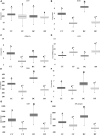Carry-Over Effects of Desiccation Stress on the Oxidative Status of Fasting Anuran Juveniles
- PMID: 34925072
- PMCID: PMC8674722
- DOI: 10.3389/fphys.2021.783288
Carry-Over Effects of Desiccation Stress on the Oxidative Status of Fasting Anuran Juveniles
Abstract
Amphibians are sensitive to deteriorating environmental conditions, especially during transition to a terrestrial environment which is full of uncertainties. Harsh conditions, such as desiccation during earlier stages, affect different larval traits with possible carry-over effects on juvenile and adult life histories. The first consequences of the effects can be seen in juveniles in the challenges to find food and the ability to survive without it in a terrestrial habitat. Body size and the internal energy reserves acquired during the larval phase play an important role in this period. Herein, we tested how different water regimes (low water availability, desiccation and constant high-water availability) during larval development reflect on the oxidative status and ability of yellow belly toad (Bombina variegata) juveniles to endure short-term fasting. The desiccation regime significantly reduced the body size of metamorphs. The same was observed after 2 weeks of fasting, while the feeding treatment reduced differences mostly in the body mass of individuals from different water regimes. This was the result of a greater gain in mass in juveniles pre-exposed to desiccation. Pre-exposure to desiccation also modified the parameters of the antioxidant system (AOS) under feeding conditions, leading to higher values of superoxide dismutase, glutathione reductase and glutathione S-transferase, glutathione and sulfhydryl group concentrations, and lower glutathione peroxidase in comparison to juveniles reared under constant water. The increase in the AOS of juveniles can be considered as a physiological carry-over effect of desiccation, probably as the result of compensatory growth and/or earlier exposure to chronic stress. However, water levels during larval development did not exert significant effects on the oxidative status of juveniles subjected to food unavailability. Fasting juveniles, both control and desiccated, were exposed to oxidative stress, significantly higher lipid peroxide concentrations, lower superoxide dismutase, glutathione peroxidase, glutathione S-transferase, glutathione and sulfhydryl group values in comparison to feeding individuals. The lack of food in juvenile anurans activated the AOS response in the same manner, regardless of body size and stress pre-exposure, suggesting that the generally accepted hypothesis about the influence of metamorphic body size on the fitness of the postmetamorphic stage should be tested further.
Keywords: Bombina variegate; amphibians; antioxidant system; development; food deprivation; oxidative stress; pond drying; yellow belly toad.
Copyright © 2021 Prokić, Petrović, Gavrilović, Despotović, Gavrić, Kijanović, Tomašević Kolarov, Vukov and Radovanović.
Conflict of interest statement
The authors declare that the research was conducted in the absence of any commercial or financial relationships that could be construed as a potential conflict of interest.
Figures


Similar articles
-
Impact of desiccation pre-exposure on deltamethrin-induced oxidative stress in Bombina variegata juveniles.Comp Biochem Physiol C Toxicol Pharmacol. 2021 Dec;250:109191. doi: 10.1016/j.cbpc.2021.109191. Epub 2021 Sep 15. Comp Biochem Physiol C Toxicol Pharmacol. 2021. PMID: 34536572
-
Effects of Desiccation on Metamorphic Climax in Bombina variegata: Changes in Levels and Patterns of Oxidative Stress Parameters.Animals (Basel). 2021 Mar 29;11(4):953. doi: 10.3390/ani11040953. Animals (Basel). 2021. PMID: 33805554 Free PMC article.
-
The role of phenotypic plasticity and corticosterone in coping with pond drying conditions in yellow-bellied toad (Bombina variegata, Linnaeus 1758) tadpoles.J Exp Zool A Ecol Integr Physiol. 2024 Aug;341(7):753-765. doi: 10.1002/jez.2819. Epub 2024 Apr 23. J Exp Zool A Ecol Integr Physiol. 2024. PMID: 38651613
-
Consequences of life history switch point plasticity for juvenile morphology and locomotion in the Túngara frog.PeerJ. 2015 Sep 22;3:e1268. doi: 10.7717/peerj.1268. eCollection 2015. PeerJ. 2015. PMID: 26417546 Free PMC article.
-
Dietary glycation compounds - implications for human health.Crit Rev Toxicol. 2024 Sep;54(8):485-617. doi: 10.1080/10408444.2024.2362985. Epub 2024 Aug 16. Crit Rev Toxicol. 2024. PMID: 39150724
Cited by
-
Mapping the correlations and gaps in studies of complex life histories.Ecol Evol. 2023 Feb 17;13(2):e9809. doi: 10.1002/ece3.9809. eCollection 2023 Feb. Ecol Evol. 2023. PMID: 36820248 Free PMC article.
-
Framework for multi-stressor physiological response evaluation in amphibian risk assessment and conservation.Front Ecol Evol. 2024 Mar 13;12:1-16. doi: 10.3389/fevo.2024.1336747. Front Ecol Evol. 2024. PMID: 39679000 Free PMC article.
References
-
- Addinsoft XLSTAT (2015). Data Analysis and Statistics Software for Microsoft Excel. Paris: Addinsoft.
-
- Allen R. G. (1991). Oxygen-reactive species and antioxidant responses during development: the metabolic paradox of cellular differentiation. Proc. Soc. Exp. Biol. Med. 196 117–129. - PubMed
-
- Arendt J. D., Wilson D. S. (2000). Population differences in the onset of cranial ossification in pumpkinseed (Lepomis gibbosus), a potential cost of rapid growth. Can. J. Fish. Aquat. Sci. 57 351–356. 10.1139/f99-250 - DOI
LinkOut - more resources
Full Text Sources

